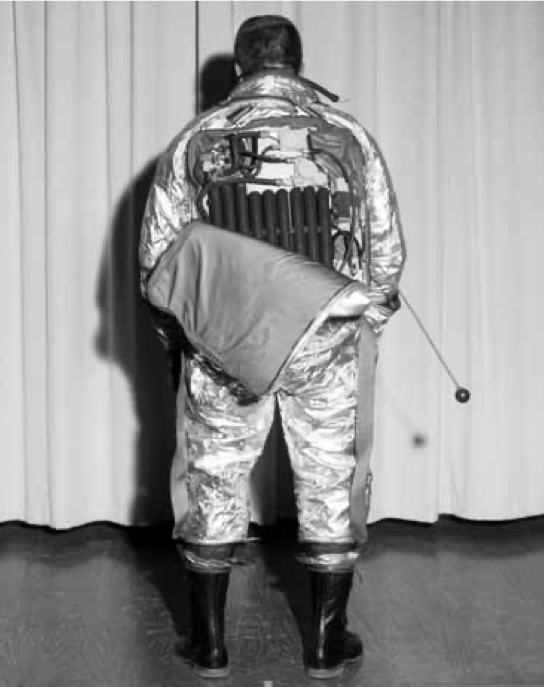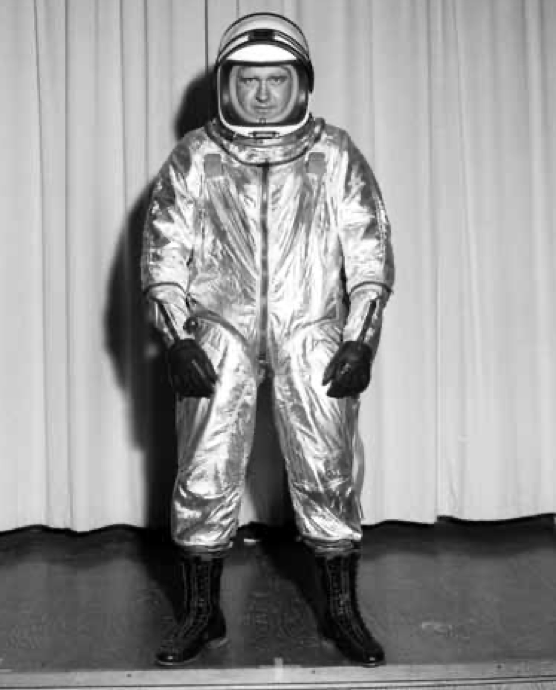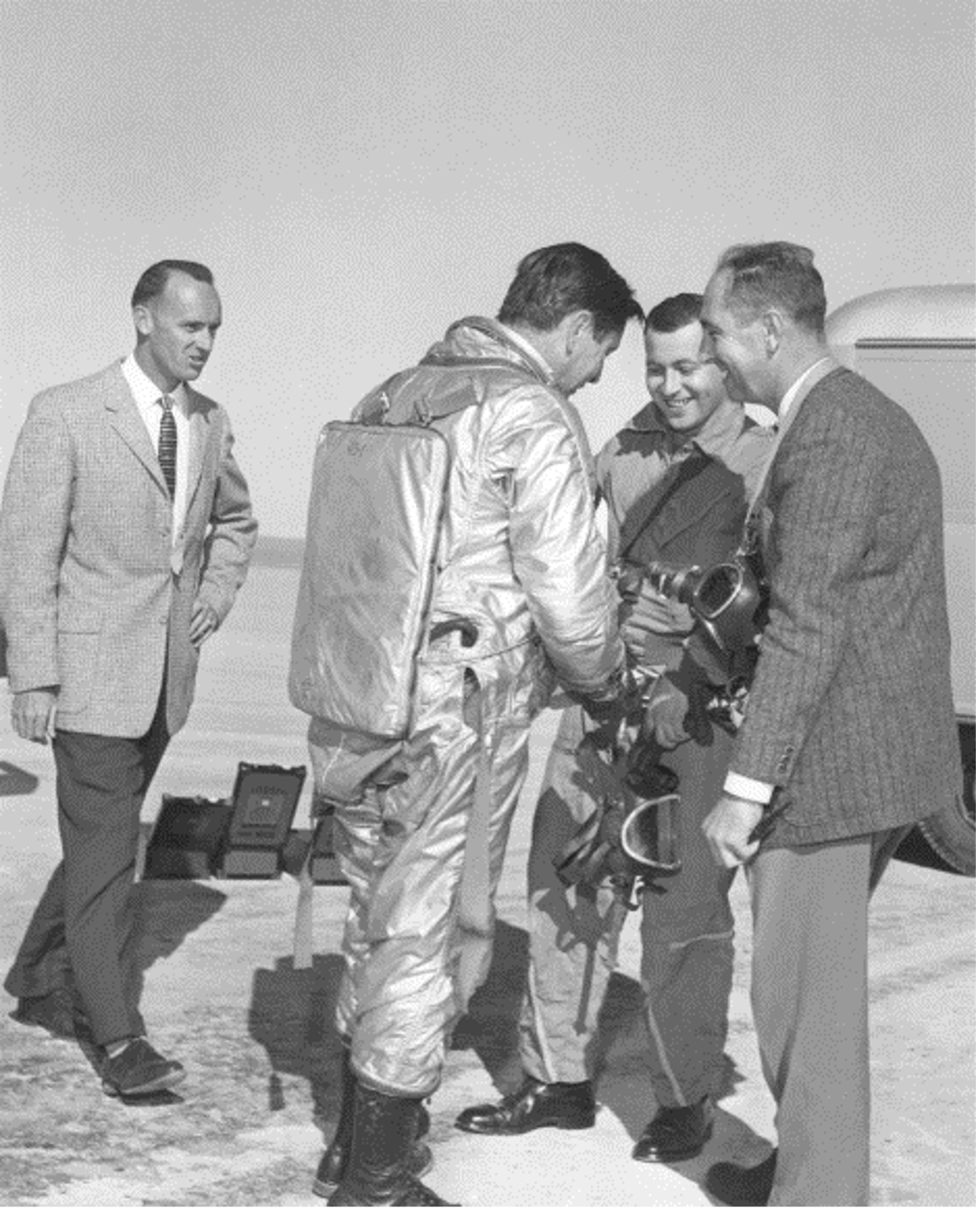The Museum will be closed January 12th - January 16th in preparation for our new Special Exhibition Ripley's Believe It or Not!. Museum reopens Saturday January 17th. New Exhibit opens January 31st!
It all started with SDASM Museum curators taking apart an exhibition to give space for a new one. One of the objects had no tag and was photographed, measured and entered into the Museum collection database as an “unidentified object.” It was given the following description: “Object is a silver rectangle with a zipper and resembles a bag, back pack, or seat cover. Object has the number "59" written in black marker on the top and bottom of both sides. Object has the name "Neil Armstrong" stamped on one side with seven circular and rectangular cut outs. Interior of the object is green.”


Both sides of the mystery object.
The search for photographs of Neil Armstrong wearing a silver flight suit led to his earlier career before he landed on the moon, Neil Armstrong was an X-15 test pilot. The North American X-15 is a hypersonic rocket-powered aircraft. It was operated by the United States Air Force and the National Aeronautics and Space Administration as part of the X-plane series of experimental aircraft. The first X-15 flight was an unpowered glide flight by Scott Crossfield, on June 8, 1959. Crossfield also piloted the first powered flight on September 17, 1959, and his first flight with the XLR-99 rocket engine on November 15, 1960. Twelve test pilots flew the X-15. Among these were Neil Armstrong, later a NASA astronaut and the first man to set foot on the Moon, and Joe Engle, later a commander of NASA's Space Shuttle missions.

The photo above shows the X-15 ship #3 (56-6672) in flight over the desert in the 1960s.
X-15 #3 made 65 flights during the program, attaining a top speed of Mach 5.65 and a maximum altitude of 354,200 feet. Only 10 of the 12 X-15 pilots flew Ship #3, and only eight of them earned their astronaut wings during the program. Robert White, Joseph Walker, Robert Rushworth, John “Jack” McKay, Joseph Engle, William “Pete” Knight, William Dana, and Michael Adams all earned their astronaut wings in Ship #3. Neil Armstrong and Milton Thompson also flew Ship #3. In fact, Armstrong piloted Ship #3 on its first flight, on December 20, 1961.

NASA pilot Neil Armstrong is seen here in the cockpit of the X-15 ship # 1 (56-6670) after a research flight in 1961.
On April 10, 1958, the Aero Medical Laboratory advised the X-15 Project Office that David Clark Company planned to deliver the first flight-qualified suit (S794-6) for Scott Crossfield on June 1, 1958. On May 3, 1958, the configuration of the S794-6 suit to be delivered to Crossfield was frozen during a meeting in Worcester between representatives of David Clark Company, North American, and the USAF. Nevertheless, the X-15 Project Office advised the newly assigned chief of the Aero Medical Laboratory, Col. John P. Stapp, that the suit delays might postpone the entire X-15 effort. To maintain the schedule, the X-15 program needed to receive Crossfield’s suit by January 1, 1959, a second suit by February 15, and the remaining four suits by May 15. Subsequently, the X-15 Project Office found additional funds for the MC-2, and David Clark tailored eight suits for the individual X-15 pilots. These included Neil A. Armstrong (NASA), Scott Crossfield, Capt. Iven C. Kincheloe, Jr. (USAF, killed prior to his first X-15 flight), John B. “Jack” McKay (NASA), LCDR Forrest S. Petersen (U.S. Navy), Lt. Col. Robert A. Rushworth (USAF), Joseph A. Walker (NASA), and Maj. Robert M. White (USAF).

NASA test pilot Neil Armstrong is seen here next to the X-15 ship #1 (56-6670) after a research flight in 1961.
After looking through a few photographs online with none of the images demonstrating anything resembling the “unidentified” object this particularly unique photograph was found with Neil Armstrong standing sideways in a half turn.


NASA research pilot Neil Armstrong is seen here next to the X-15 ship #1 (56-6670) after a research flight. Armstrong made his first X-15 flight on November 30, 1960, in the #1 X-15. He made his second flight on December 9, 1960, in the same aircraft.
A match was found, but what about identifying the mysterious object? Reading “Dressing for Altitude: U.S. Aviation Pressure Suits - Wiley Post to Space Shuttle” by Dennis R. Jenkins presented an answer.


Test pilot Jack McKay models an MC-2 suit. Emergency oxygen cylinders in the back kit.
But what about the number “59” written on not anymore, a “mysterious object”, but a back kit of MC-2 suit with the name of legendary Neil Armstrong? After contacting HQ of the manufacturer of MC-2 suits David Clark Company Inc., consultations with National Air and Space Museum, NASA Armstrong Flight Research Center there was still no definitive answer.

Chief engineering test pilot for North American Aviation Scott Crossfield in one of the rare photographs demonstrating number “43-1” written on his MC-2 back kit. Image by Dryden Flight Research Center NASA.
Each MC-2 suit consisted of a ventilation garment, chloroprene-coated nylon twill upper and lower-torso gas containers, Link-Net upper and nylon lower-restraint garments, and a one-piece aluminized exterior cover. The neoprene-coated ripstop fabric ventilation garment also included a porous wool-insulation layer. The upper and lower gas containers formed a seal at the waist by having their edges folded together three times. The lower gas containers incorporated a G-suit similar to standard USAF G-suits that provided protection up to about 7-G. The suit included a biomedical instrumentation pass-through that accommodated in-flight medical monitoring of the pilot. The helmet hold-down system consisted of a steel cable that attached to the bottom of the helmet and ran through epaulets on the restraint layer.

Flight suit held in the SDASM collection, worn by Scott Crossfield on his last flight in the North American X-15.
The exterior cover was not required for altitude protection, but the reflective aluminized-nylon sunback-fabric cover contained the seat restraint, shoulder harness, and parachute attachments, and it provided a small measure of additional insulation against extreme temperature. It also protected the pressure suit during routine use and served as a sacrificial garment during high-speed ejection. This was among the first of the silver “spacesuits” that found an enthusiastic reception on television and at the movies.
Special thanks for support and collaboration to David Clark Company, Inc. Director of Aerospace Life Support Systems Donald B. Tufts; the Chief Historian at the NASA Armstrong Flight Research Center, Logical Innovation, Inc. Christian Gelzer; the National Air and Space Museum Reference Archivist Brian Nicklas and the former NASA Dryden Flight Research Center Archivist, freelance journalist Peter Merlin.
2001 Pan American Plaza, San Diego, CA
Phone: 619.234.8291
Información En Español
Contact Us
We would like to thank all our sponsors who help us make a difference. Click here to view all who help us.

The San Diego Air & Space Museum is a 501(c)(3) non-profit organization. Federal Tax ID Number 95-2253027.
